Catching up With the Best of the Decade!
ZekeFilm recently published our Top Films of the Decade 2010-2019 list, as well as individual top ten lists from ZekeFilm critics focusing on the films of 2019. As thorough as these lists are, there are always movies that fall through the cracks. We critics try to see as many films as we can in any given year, but it’s an impossibility to see everything. This month’s edition of ZekeFilm’s Film Admissions is all about notable films from the past decade that our critics only recently watched. Better late than never!
– Max Foizey
12 Years a Slave
2013, Summit Entertainment, dir. Steve McQueen
By Taylor Blake
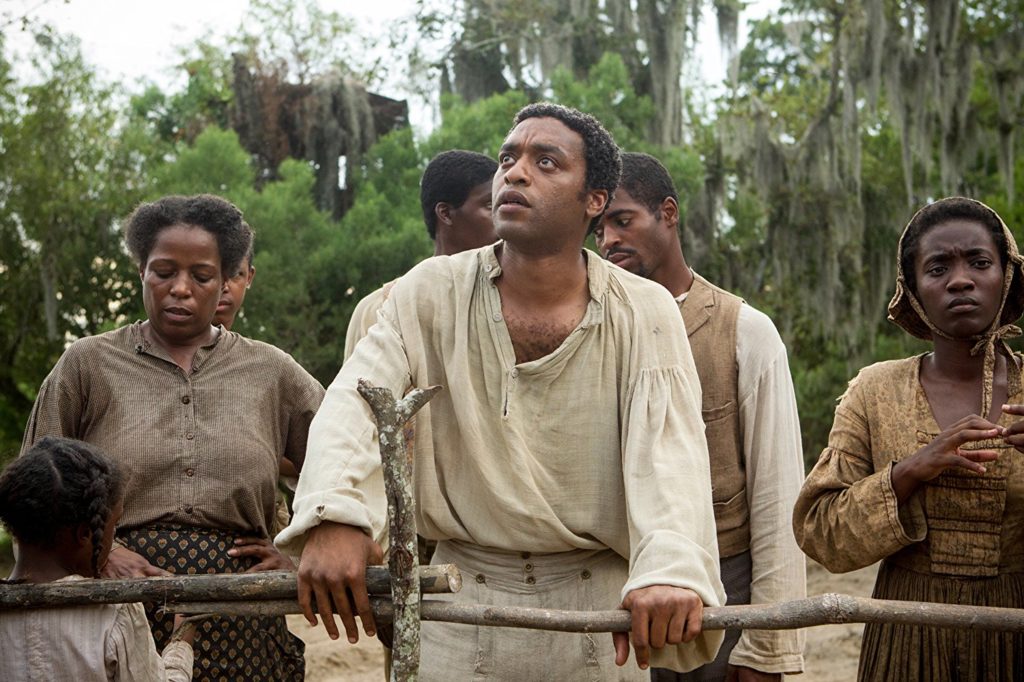
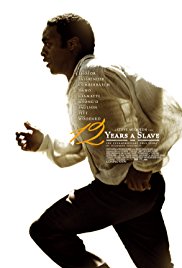
It wasn’t hard to pick a movie I was embarrassed to admit I hadn’t watched in the 2010s—12 Years a Slave was the only Best Picture winner I hadn’t seen.
What’s harder to admit is why, which, clearly, wasn’t for lack of time. The reason I delayed my viewing six years (and full disclosure: quite close to this piece’s deadline) was because I didn’t think I could hack it. I almost couldn’t finish Schindler’s List—why would I choose to sit through another realistic depiction of brutality only a few generations removed?
If you’ve asked yourself the same question, know that those concerns are not ill-founded. If Tarantino’s stylized violence in Django Unchained made you squeamish, Steve McQueen’s study of the dehumanizing treatment of pre-Civil War slaves won’t gloss over anything to make you more comfortable. Of course, that’s not only warranted, it’s why this film works so well.
Everything is a study of contrasts. Masters hang their slaves in the wild beauty of the Southern forests. Mistresses attack their slaves with expensive china. Overseers taunt their slaves with music to drown out their spirituals. The religious use the Bible as a weapon against the slaves who pray for deliverance. McQueen forces us to sit with these contradictions for long, unbroken shots. We sit and mourn with Solomon (Chiwetel Ejiofor) with every betrayal, watching and feeling his grief until it becomes our own. As he is moved from auction to house to plantation, the turmoil of his fellow victims becomes ours, too. We watch white actors we respect and praise become weakly selfish at best, manically barbaric at worst, so we know why it’s so difficult for Solomon to know whom he can trust. It also reminds us if faces we thought we liked so much could portray such evil, we must be capable of such evil as well. (See Jojo Rabbit for another reminder of that.)
There’s no beauty or redemption in this chapter of America’s story, but the beauty of this film is it restores humanity to the memory of the millions of people who were denied it in their lifetimes. Instead of being grouped together as collective “slaves,” they’re Solomon and Patsey (Lupita N’yongo) and Eliza (Adepero Oduye) and Emily and Robert and Jasper and Anna and Clemens. They have faces and names and families and scars, and 12 Years a Slave finds and shows them better than any movie about American slavery yet.
The Wolf of Wall Street
2013, EMJAG Productions, dir. Martin Scorsese
by Robert Hornak

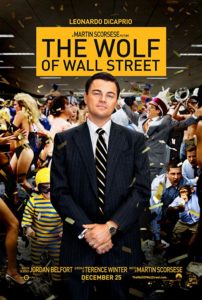
I began with The Wolf of Wall Street. Propulsive, energetic, youthful, cocky, dangerous – everything you don’t expect from a 71-year-old man, but have come to expect from the English-speaking world’s greatest director. Wedged between such disparate outings as Hugo (2011) and Silence (2016), you’d think this was a man floundering on his foot, wondering who he was as an artist, but here’s a movie so precise and explicit and knowing and right about the corrupted husk of American finance, and so sinewy and invigorating in its technical presentation of a story that should make you recoil, that you’re nevertheless glued to the screen like Belfort to a line of coke. You have fun watching the whole thing rise out of the dirt of a distant stock into a disco ball of Boschian debauchery – but that’s just the first forty minutes. By an hour in, I’ll admit, it started to get to be a bit much for me. Having recently experienced The Irishman, I was sustained for just a bit longer by my fascination with the pliability of Scorsese’s decades-old, film-a-sleazy-guy’s-real-life template – but even that wasn’t enough to fully justify this heady a Nestea plunge into gleeful amorality, and three hours of it. So I may lose critic-cred, but I tucked tail and saved the last two hours for my alternate Admission:
Force Majeure
2014, ZDF/Arte, dir. Ruben Östlund
by Robert Hornak
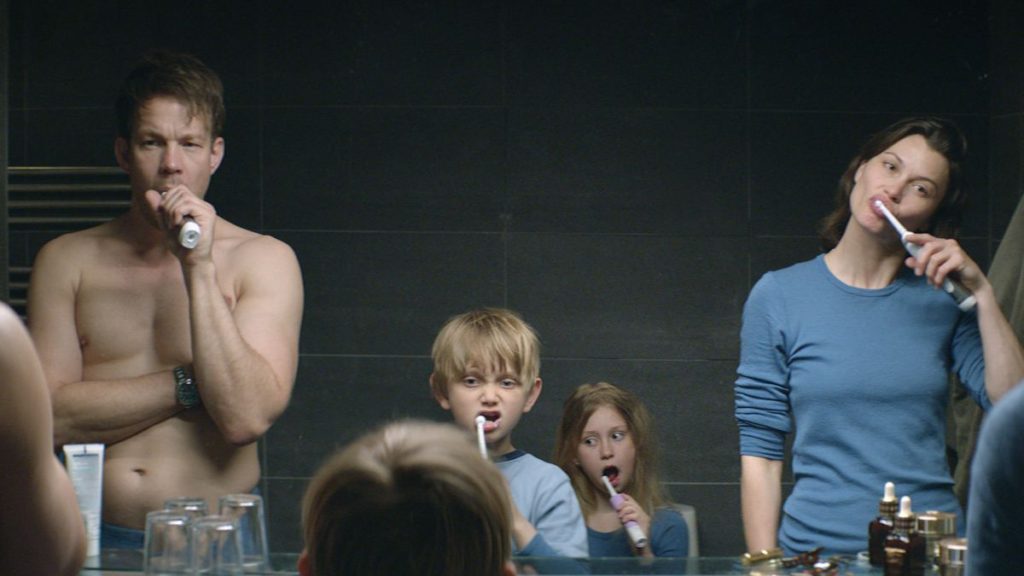
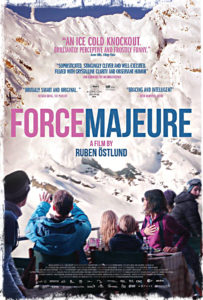
At the time, 2014, all the buzzy press called it a “pitch-black satire” or some variation, which should have put it to the front of my queue. Somehow I missed it and it’s remained on my guilty to-do list ever since. Well, maybe I’m too married, but nothing about this movie seems funny – or even feels like it was trying to be – and maybe the air’s just too thin up here, but I don’t really know what it’s satirizing either. But I love it, whatever it is, and I’m glad I waited, because it’s one that fits the current political mood like a ski boot. Refresher: family ski vacation gets a jolt when they’re caught in an avalanche at a mountain view restaurant. Dad panics, bolts, while mom stays hunched around the kids. All end up safe but are left to slalom through the aftermath of dad’s cowardice. What gives the movie fresh immediacy is the focus for much of the rest of the running time on dad’s refusal to accept a fact that all witnessed, and that was even captured on his own phone video. His denial, not born of trauma but of pride, meets with mom’s peacekeeping concessions – until her disappointment pushes her love for him out into the drift. It’s a movie about watching someone you love get buried in alternative facts until you don’t know who they are anymore, a sober parable of the fragility of perceptions, especially inside marriage, and especially now. Not sure what’s funny there…but I’m sure the American remake in 2020, starring Will Ferrell and Julia Louis-Dreyfus, will milk it for all the shtick the chilly Swedes overlooked.
The Tree of Life
2011, Plan B Entertainment, Terrence Malick
by Erik Yates
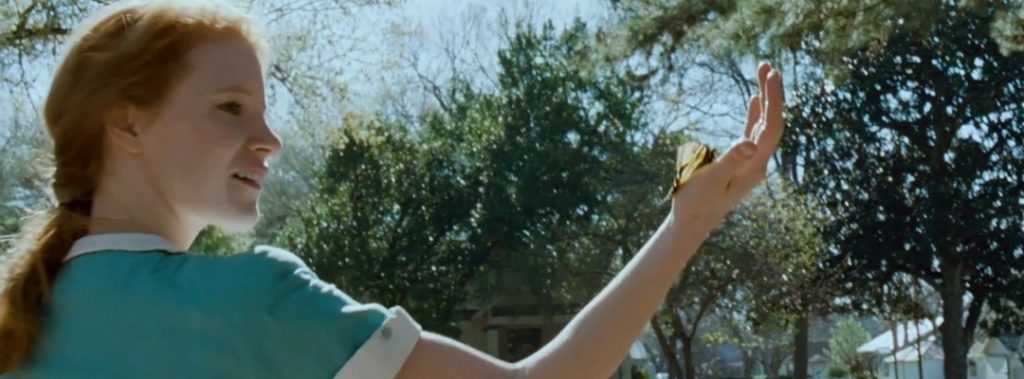
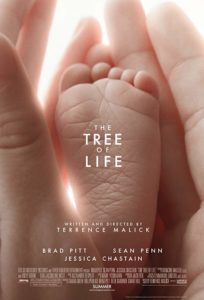
Of the many films I could admit having not seeing this decade, nothing stood out more prominently than Terrence Malick’s The Tree of Life. An impressionistic piece, through and through, The Tree of Life grapples with the larger questions of existence and faith in the midst of a world where one’s experiences can easily bring disillusionment and skepticism.
Jack (Sean Penn) is looking back on his life, where he grew up living outside Waco, Texas, with a loving mother (Jessica Chastain) and a strained relationship with his father (Brad Pitt). While Malick would explore this impressionistic form again in films like To the Wonder and Knight of Cups, The Tree of Life is easily his impressionistic magnus opus. Emmanuel Lubezki, who has been the cinematographer for Malick’s To the Wonder and Knight of Cups, as well as on other films such as Gravity, The Revenant, and Birdman or (The Unexpected Virtue of Ignorance), truly makes every frame of The Tree of Life a living, breathing canvas. This is true whether presenting the origin of the universe, using very practical effects, or capturing the daily roaming of a teenager around Waco in the 1950’s. Each shot is worthy of being framed and displayed in the finest art galleries of the world.
While The Tree of Life is more about the feelings and mood that one feels growing up and pondering the meaning of life, Malick’s minimalist dialogue effectively carries the narrative, largely on the backs of the fantastic performances by Brad Pitt and Jessica Chastain. Chastain in particular is able to convey a myriad of sides of her character from loving mother, to dutiful wife, flipping on a dime when her children need her to be their fierce protector, all in a time when society had very firm expectations of a woman’s role in their family. The Tree of Life doesn’t offer any ultimate answers to the questions it ponders, but it isn’t meant to. Sometimes, life is about the journey with all of its highs and lows. As Sean Penn’s Jack journeys to reconcile his life’s experiences and the hope and disillusionment they have brought him with the larger questions he is asking about God, love, and the universe, we too are presented with audio and visual expressions of what that feels like and can easily relate. The Tree of Life is about how we are all trying to return to that perfect garden of long ago where life sprang forth, with all of its possibilities, and reconciling it with the disillusionment of modernity and destructive nature of the world we all share. I am happy to say that I have finally seen this brilliant and beautiful film before the decade of its release has passed me by.
A Separation
2011, Memento Films, dir. Asghar Farhad
by Jim Tudor
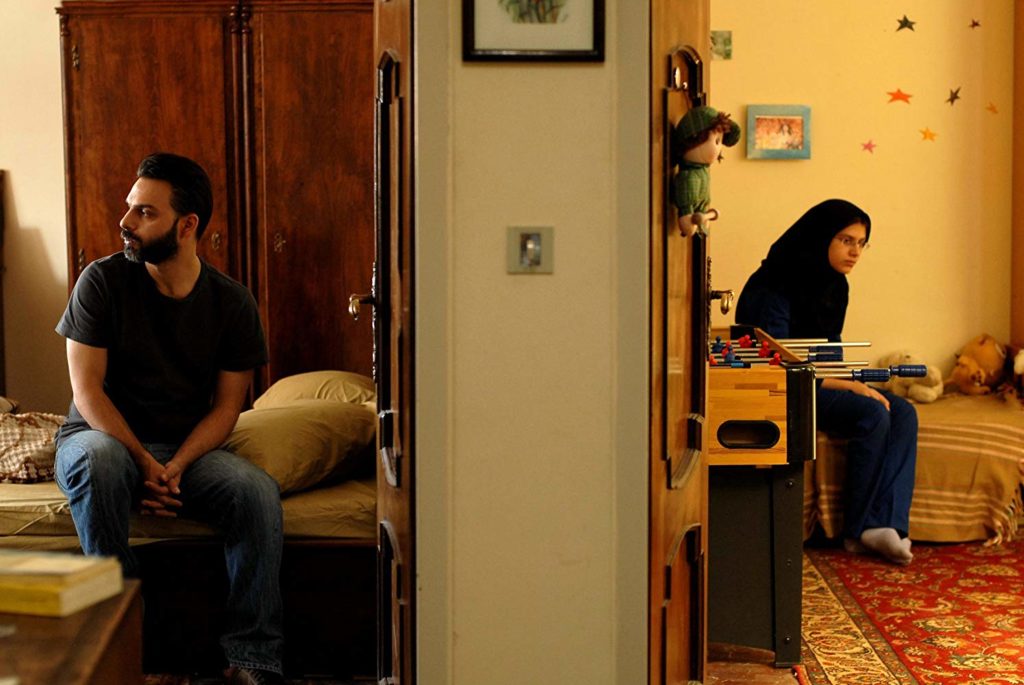
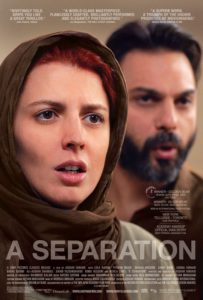
Of the “big three“ internationally known Iranian film directors of recent decades (those being the late Abbas Kiarostami, as well as Jafar Panahi, and Asghar Farhadi), it can be pointed out that Farhadi is the most overtly dramatic in his work. Also, as far as his home country is concerned these days, he’s also the most urban. While Panahi takes his camera to remote villages on the sly for 3 Faces and Kiarostami takes his camera to the grave with 24 Frames, Farhadi tools around the developed cities, showcasing the relational issues of characters who in fact are not poor. All three filmmakers very much strive for depicting relatable raw humanity as opposed to blatant politics in the stories they choose tell. That, one confidently suspects, is why they’ve made an impact around the globe. That, and their shared flair for simulated documentary realism.
In the early years of the second decade of this century, Iranian cinema became prominent in a way that it hadn’t been since before the mid-1990s. A major part of that was Farhadi’s heart-wrenching tale of a family in strife, A Separation (Jodaeiye Nader az Simin). Released in 2011 and picked up by Sony Pictures Classics, A Separation went on to win numerous awards, including Best Foreign Language Film at the Academy Awards. It was also nominated for Best Original Screenplay (the film was also written by Farhadi, losing to Woody Allen’s Midnight in Paris), a particularly well-deserved nod, considering that so much of A Separation hinges on a complex network of key moments, all hiding in plain sight. With Farhadi’s use of handheld camera and tactile, real-world locations, the sheer clockwork of the story is virtually invisible upon first viewing. And like day to day life, the characters have trouble recalling the specifics of where they were and who said what several scenes ago. Who knew in the moment that so much would later hinge on those instances?
As one might guess in the case of a film as emotionally complex as this one is, the starkness of the title reflects its own multi-layered nature. As the film opens, the main couple, Simin (the wonderfully expressive Leila Hatami) and Nader (a brilliantly slow-crumbling Payman Moadi) are indeed in the midst of legally dissolving their marriage. Simin wants to take their tweenage daughter out of the country, presumably to a less patriarchally oppressive place. Nader feels that he cannot go, due to his responsibilities in caring for his geriatric father. He hires Razieh (Sareh Bayat), a young very pregnant and very religious woman, to care for him during the day. When things go south in this arrangement, the legal ramifications are multi-pronged. The personal ramifications are seismic. Separations do and will abound.
For me, as a newly gilded critic in 2011, A Separation came out of nowhere at the crux of a particularly exhausting screener/awards season. It is the film I ended up skipping- a particularly regrettable choice, considering not only its year-end success then, but also it’s continuing stature as one of the great films of the past ten years. Now, as our country ramps up for possible war with Iran, and with the close of the decade and all the list-making considerations that come with that, it seems to be a particularly good time to get at the universally human side of what we often consider a very foreign country, as well as get acquainted with the film that put Asghar Farhadi on the international map. In this time, dare I say, it is particularly important that we do not remain separated from great Iranian cinema.
If Beale Street Could Talk
2018, Annapurna Pictures, dir. Barry Jenkins
by Max Foizey
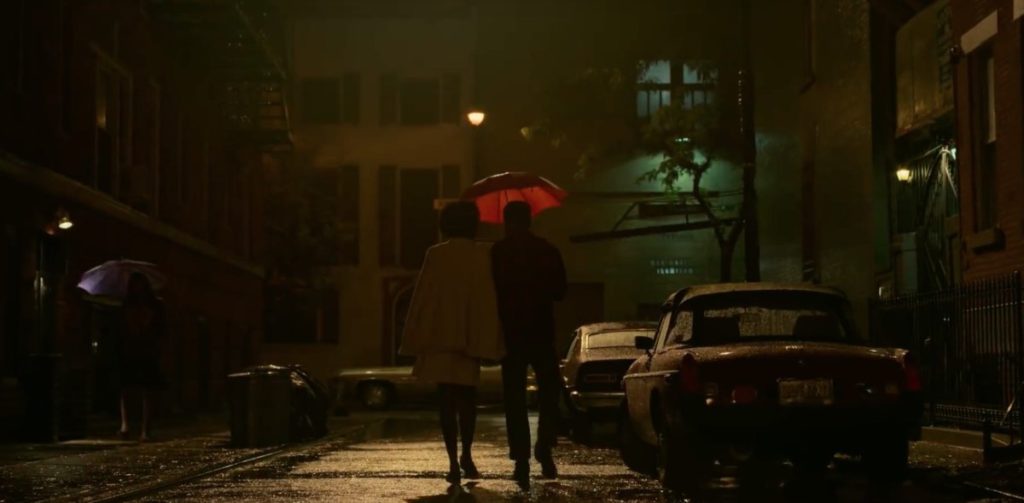
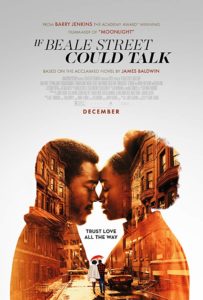
Tish (KiKi Layne) is 19, Fonny (Stephan James) is 22, and in jail. He’s accused of a rape he almost certainly could not have committed, but the police don’t seem to care if they have the right person behind bars. Tish visits the incarcerated Fonny and tells him they’re having a baby. Having known each other since childhood, their bond is strong. Tish and her mother Sharon (Regina King) work with lawyers to free Fonny, while dealing with ire from his family, who aren’t supportive of Fonny and Tish’s union. This is a story about people trying to do the most simple things in life in the face of hardship: fall in love, have a baby, find a place to live, make dinners, spend time with family and friends. Things we should all be free to pursue.
KiKi Layne and Stephan James are perfect leads, truly bringing Tish and Fonny to life. The supporting cast is aces, with Diego Luna, Pedro Pascal, and Brian Tyler Henry being highlights. Regina King won the Academy Award for Best Supporting Actress for her work as Sharon, and the film also received nominations for Best Adapted Screenplay and Best Score.
The first thing you notice about the film is the music. Nicholas Britell’s sublime score of strings and saxophone weave in and out of scenes like the wind itself, like the emotions of the characters made tangible. It’s the best work of Britell’s career. James Laxton’s cinematography is impressive as well, making a good case for the power of the close up. As a rule I prefer wide shots in films as too many close ups can get tiresome or feel too much like an episode of a TV show, but here the characters look directly into the camera, asking the audience to connect with them, a plea for empathy.
Based on James Baldwin’s novel and written for the screen and directed by Barry Jenkins as his follow-up to his masterpiece Moonlight, If Beale Street Could Talk opens with Baldwin’s text on screen; “Beale Street is a loud street.” This gorgeous, contemplative film serves as both a heartbreaking love story and a demand that we as a country do better by our citizens. Unjust incarceration of people of color is still a major issue in our nation. Baldwin wrote his novel in 1974, but it absolutely resonates today. Things haven’t changed enough when it comes to our society and the legal system’s treatment of minorities. As Billy Preston’s rendition of My Country ‘Tis of Thee plays over the end credits, you are reminded that Beale Street is still a loud street, and this story will echo in your mind long after it ends.

